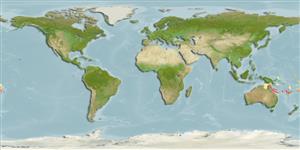分類 / Names
共通名の | 類義語 | Catalog of Fishes(部類, 種) | ITIS | CoL | WoRMS | Cloffa
>
Perciformes/Serranoidei (Groupers) >
Anthiadidae (Fairy basslets or Streamer basses)
Etymology: Rabaulichthys: Perhaps from Rabaul, the capital of Papua New Guinea + Greek, ichthys = fish.
More on authors: Randall & Walsh.
Environment: milieu / climate zone / depth range / distribution range
生態学
海 関連する礁; 深さの範囲 6 - 54 m (Ref. 90856). Tropical
Western Pacific: Australia,
サイズ / 重さ / 年齢
Maturity: Lm ? range ? - ? cm
Max length : 6.2 cm SL オス/雌雄の選別がない; (Ref. 90856)
簡単な記述
検索表 | 形態学 | 形態計測学
背面の脊椎 (合計) : 10; 背鰭 (合計) : 16; 肛門の骨: 3; 臀鰭: 7; 脊つい: 26. This species is distinguished by the following characters: D X,16; A III,7; pectoral rays 19--21 (rarely 21); lateral-line scales 51-59; gill rakers 9 + 23-24; body depth 23.8-25.3% SL; head length 28.5-30.6% HL; snout length 6.8-7.4% SL; longest dorsal spine of mature males 28.7-31.3% SL; caudal fin of mature males 31.8-35.8% SL; absence of black band in soft portion of dorsal fin; a series of indistinct dark bars of unequal width in middle third of standard length, none with pale margins; in life, colour light red with scale centres pale, dark bars reddish brown; an oblique, pale-edged, brownish orange band from snout through eye and across cheek; pelvic fins black with red rays; colour of remaining fins pink to yellowish (Ref. 90856).
The species is usually found over open stretches of coral rubble, and therefore avoid the many predators of coral reefs; form small aggregations that feed on zooplankton above the substratum (Ref. 90856).
Life cycle and mating behavior
Maturities | 繁殖 | Spawnings | Egg(s) | Fecundities | 幼生
Randall, J.E. and F, Walsh, 2010. Rabaulichthys squirei, a new species of Sailfin Anthias (Serranidae: Anthiinae) from the Coral Sea. Memoirs of the Queensland Museum - Nature 55(1):205-211. (Ref. 90856)
Human uses
用具
特記事項
XMLをダウンロードして下さい
インターネットの情報源
Estimates based on models
Preferred temperature (Ref.
123201): 25.9 - 27, mean 26.3 °C (based on 20 cells).
Phylogenetic diversity index (Ref.
82804): PD
50 = 0.5625 [Uniqueness, from 0.5 = low to 2.0 = high].
栄養段階 (Ref.
69278): 3.3 ±0.4 se; based on size and trophs of closest relatives
Fishing Vulnerability (Ref.
59153): Low vulnerability (10 of 100).
